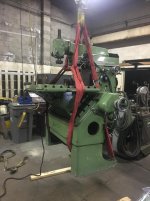Halcohead
Stainless
- Joined
- Apr 10, 2005
- Location
- Bay Area, Ca
Been pretty dissatisfied with all the Bridgeports I've run, so I've decided to try out a Deckel:
![IMG_8189[1].jpg IMG_8189[1].jpg](https://www.practicalmachinist.com/forum/data/attachments/177/177895-2210d4b43dc3782a02c4a37dd1597329.jpg)
I'm a little ashamed to move such a clean machine into my filthy shop, but it'll at least remain covered when not in use.
I expect to have a number of questions but will of course use search first.
For starters though, what do people do for power tapping on single-motor Deckels? Previous threads seem to indicate running a VFD to reverse the motor shouldn't hurt so long as the feeds aren't used? Do I have to get over my aversion to tapping heads?
Speaking of VFD's, 2000 RPM ain't that fast. I've found no mention of folks using VFD's to overspeed the motor. Is this likely to hurt the spindle bearings or feedworks?
I'm glad this machine seems to be in good shape and well maintained, but not pristine. I'm buying it to use it, so if it were much nicer and I might feel guilty when it starts slinging chips.
(Can't get the second photo to rotate, alas)
![IMG_8189[1].jpg IMG_8189[1].jpg](https://www.practicalmachinist.com/forum/data/attachments/177/177895-2210d4b43dc3782a02c4a37dd1597329.jpg)
I'm a little ashamed to move such a clean machine into my filthy shop, but it'll at least remain covered when not in use.
I expect to have a number of questions but will of course use search first.
For starters though, what do people do for power tapping on single-motor Deckels? Previous threads seem to indicate running a VFD to reverse the motor shouldn't hurt so long as the feeds aren't used? Do I have to get over my aversion to tapping heads?
Speaking of VFD's, 2000 RPM ain't that fast. I've found no mention of folks using VFD's to overspeed the motor. Is this likely to hurt the spindle bearings or feedworks?
I'm glad this machine seems to be in good shape and well maintained, but not pristine. I'm buying it to use it, so if it were much nicer and I might feel guilty when it starts slinging chips.
(Can't get the second photo to rotate, alas)



 . I would have little concern running the spindle speeds up to 2,500 and maybe 3,000 RPM, but would want to disassemble, clean, get clearances right, and re-grease, and then monitor temperatures closely.
. I would have little concern running the spindle speeds up to 2,500 and maybe 3,000 RPM, but would want to disassemble, clean, get clearances right, and re-grease, and then monitor temperatures closely. 


